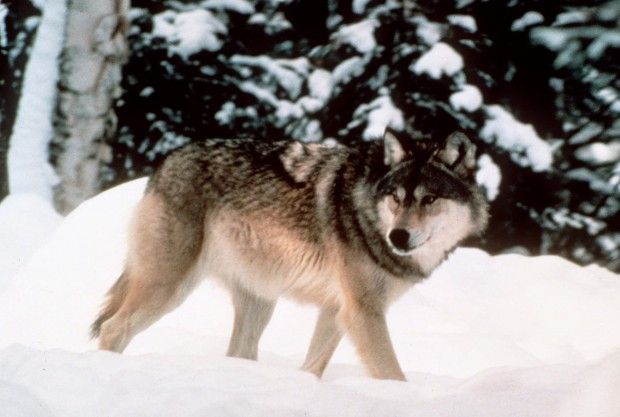HAMILTON – While wolf numbers
are expected to remain relatively stable in the Bitterroot watershed, a
state biologist said densities of the predator have been on a bit of an
upswing in the valley’s northern reaches.
That change may be the result of an earlier focus on wolf hunting and trapping in the southern Bitterroot Valley, Montana Fish, Wildlife and Parks wolf biologist Liz Bradley said Tuesday.
The number of packs remains the same in the southern reaches of the Bitterroot, but there are fewer animals in each pack.
There are a few new packs in the northern Bitterroot and there tend to be larger numbers of wolves in each pack, Bradley said.
There are a total of 15 confirmed packs in the Bitterroot. Bradley expects the soon-to-be-released 2013 annual monitoring report will say that, at a minimum, there are 60 to 70 wolves in the watershed. “Overall, over the last five years the numbers of wolves in the Bitterroot have remained steady,” she said. “The distribution has changed a little bit. There will be shifts from one year to the next.”
Bradley is currently working through information gathered during past wolf hunting and trapping seasons to determine what kind of impacts that activity had on different packs.
For instance, for years one of the packs she monitored was in the Welcome Creek area of the Sapphire Range. When the alpha female of the pack died, the male started a new pack in the Burnt Fork area.
He and several others from another pack in the Ambrose Creek area were killed by trappers this year. “They were new packs and now obviously they may not be there anymore,” Bradley said. “I know there are still a few wolves left in that area.”
This year, hunters and trappers killed a total of 20 wolves in the Bitterroot watershed. Each group took 10 animals.
That total number is six more than were killed the year before.
The public can help track wolves in the Bitterroot by calling Bradley at 542-5523 with information about sightings. That information can also be given online on the FWP website.
Identifying a wolf is not always an easy task.
Bradley received reports earlier this week of wolves chasing elk on the southern edge of Hamilton.
A woman who saw what looked to be a wolf chasing elk out of her yard Tuesday morning. Her neighbor thought it was a wolf as well.
She later saw the large canines near a woman on the walking trail and determined the animals were actually dogs.
Bradley said she occasionally gets reports of wolf sightings on the valley floor during the winter and early spring when a heavy snowpack drives elk down. “It’s not super common,” she said. “Usually when I get reports of wolves in the valley, they tend to move on. … They really don’t want to be around people, especially since we’ve started hunting them.”
“That’s one of the advantage of hunting. We want them to retain their fear of people,” she said.
source
That change may be the result of an earlier focus on wolf hunting and trapping in the southern Bitterroot Valley, Montana Fish, Wildlife and Parks wolf biologist Liz Bradley said Tuesday.
The number of packs remains the same in the southern reaches of the Bitterroot, but there are fewer animals in each pack.
There are a few new packs in the northern Bitterroot and there tend to be larger numbers of wolves in each pack, Bradley said.
There are a total of 15 confirmed packs in the Bitterroot. Bradley expects the soon-to-be-released 2013 annual monitoring report will say that, at a minimum, there are 60 to 70 wolves in the watershed. “Overall, over the last five years the numbers of wolves in the Bitterroot have remained steady,” she said. “The distribution has changed a little bit. There will be shifts from one year to the next.”
Bradley is currently working through information gathered during past wolf hunting and trapping seasons to determine what kind of impacts that activity had on different packs.
For instance, for years one of the packs she monitored was in the Welcome Creek area of the Sapphire Range. When the alpha female of the pack died, the male started a new pack in the Burnt Fork area.
He and several others from another pack in the Ambrose Creek area were killed by trappers this year. “They were new packs and now obviously they may not be there anymore,” Bradley said. “I know there are still a few wolves left in that area.”
This year, hunters and trappers killed a total of 20 wolves in the Bitterroot watershed. Each group took 10 animals.
That total number is six more than were killed the year before.
The public can help track wolves in the Bitterroot by calling Bradley at 542-5523 with information about sightings. That information can also be given online on the FWP website.
Identifying a wolf is not always an easy task.
Bradley received reports earlier this week of wolves chasing elk on the southern edge of Hamilton.
A woman who saw what looked to be a wolf chasing elk out of her yard Tuesday morning. Her neighbor thought it was a wolf as well.
She later saw the large canines near a woman on the walking trail and determined the animals were actually dogs.
Bradley said she occasionally gets reports of wolf sightings on the valley floor during the winter and early spring when a heavy snowpack drives elk down. “It’s not super common,” she said. “Usually when I get reports of wolves in the valley, they tend to move on. … They really don’t want to be around people, especially since we’ve started hunting them.”
“That’s one of the advantage of hunting. We want them to retain their fear of people,” she said.
source


No comments:
Post a Comment